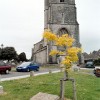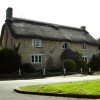Around the south shore of Poole Harbour there are saltings, mudflats across which the native marsh grass Spartina townsendii has well-established roots. The grass has been reclaiming the salt marsh since the early 1900’s, but has also been helping to re-conceal evidence of what was happening here almost nineteen centuries before: the highly significant vestiges of the pottery industry the Romano-Britons were engaged in at the time.
The Romans were quick to realise the exceptional quality of the Tertiary ball clay, which underlies much of Purbeck, and which ever since has played a major role in making the Isle one of the key sources of the raw material for ceramics now exported all over the world. Although the Durotriges, the Iron Age Celtic inhabitants of Dorset, were themselves producing pottery for local use using clay from seams in the London Clay, it was the Romans who effectively commandeered the industry, turning it to their advantage in the production of superior fine table and other wares for local, regional and even national and Empire markets.
In 1972 archaeologists were stunned to learn that cookware pottery unearthed during the excavations along Hadrians Wall had come from one of the Poole Harbour pottery sites. That the clay employed in their manufacture could only have come from Dorset was conclusively proved when David Peacock, a Southampton University geologist, conducted a heavy metal analysis of the clay in the pots. Until then, it had been assumed that the Hadrianic wares were locally produced; such a far-flung trade route had never been suspected. It was this revelation that bears witness to the efficiency of the Roman system of distribution and points to a centralised store or centre within Purbeck for supplying the Roman civil aristocracy and army.
Such dating evidence clearly points to these potteries having been worked by native Britons during the 1st and 2nd centuries AD, but then were abandoned when the potters moved to the more lucrative environment of a larger and more sophisticated pottery industry then emerging in the upland valleys of the New Forest, an area centred on the present villages of Farnham, Verwood and Alice Holt. After the full emergence of this New Forest industry by the end of the 2nd century, the potteries in Purbeck virtually ceased production until their revival during the 18th century industrial revolution.
Clays were collected on the heath and taken to a string of workshops organised on cottage industry lines along the shore of Poole Harbour, where individual craftsmen potters had their wheels and kilns. Two such kilns have been relocated a short way south of Shipstal Point on the edge of the saltings and old shore, but a number of other archaeological excavations have thrown up others. Not far north of Nutcrack Lane near Redcliffe Farm the kiln sites of other potters using wheels have been found. The presence of discarded fragments of pots at this and other sites – sometimes in large quantities – were a sure sign of a kiln below ground. These were wasters: the substandard or misfired pots rejected by the potters and smashed on a heap, which was later scattered upon abandonment of the site. The remains of what was probably a potter’s hut have been excavated at Fitzworth Point on the Frome at Stoborough. Kilns have also been re-discovered on Fitzworth Heath and on Cleavel Point (the west spit of Newton Bay) beside safe harbour beaches. But the largest concentration of kilns – over thirty – has been discovered at Bestwells Farm, between Wareham and Poole Harbour.
In 1952 a walker in Nutcrack Lane near Stoborough noticed that a number of molehills along the wayside had numerous sherds of ancient-looking pottery scattered over their surfaces. Subsequent excavation of the site unearthed a vat of puddled chalk four feet in diameter by two feet deep, with a clay lining, a central plug-hole at the bottom and five other holes in the rim. A cindery residue at the bottom contained a considerable number of sherds, pointing to the feature being a 1st century potter’s pit for puddling clay. With extreme care archaeologists lifted the basin-shaped vessel and conveyed it to the County Museum in Dorchester, where it remained on indefinite display under glass for a number of years. Unfortunately the vessel broke up during an attempt to remove it to another part of the museum in 1970, the strain evidently proving too much for its fragility and advanced age!
The native pottery style produced by these potteries is what is known as Durotrigian or Dorset Black Burnished Ware. Typically the vessels are wide bowls, urns or other forms in a hard sandy or gritty fabric and a black or grey burnishing (polishing with a pebble before firing) to produce a highly reflective surface. The Iron Age pottery (known as BB1) was usually black all over, indicating heavy reduction during firing. A variety of clays may have been used, oxides being added to colour them. The pots may have an iron rich slip or slurry finish to cover the gritty fabric. The pre-Roman Durotrigian potters could produce highly competent hand-made wares fired in bonfires or clamps. Many vessel forms used by the Romans belonged to types used on prehistoric Dorset farms, but others show that the Purbeck potters imitated continental (Belgaic) styles brought to Britain by the new colonisers, who employed the natives to supply pottery for their army.
Pottery produced on the wheel, which the Romans introduced, typically left horizontal throwing grooves on the inner side, whereas the hand-made wares of the Durotrigians often show finger marks on the insides. One problem of the potters technique, which is not fully understood is how they obtained the marked colour contrast between black and the grey surfaces, and furthermore, how the black is always well-burnished, while the grey surfaces are a dull matt and often show tool-marks.
The sites of the pits from which the clay was dug are often betrayed by mounds and depressions of extraction, small-blackened depressions indicating the former position of kilns. The kilns near the harbour shore in Purbeck were purposely sited so that the finished wares could easily be shipped from the production site without the need for any overland transportation. They are now over one hundred yards from the high water mark, but in Roman times were evidently much closer to the tidal margin of the harbour. At that time the sea level was higher or the land lower, but the tidal regression from the harbour has left behind the salt marsh we see today.
Then the mud flats were reclaimed by the Spartina grass and one of the country’s oldest industries was lost to history for centuries to come.



